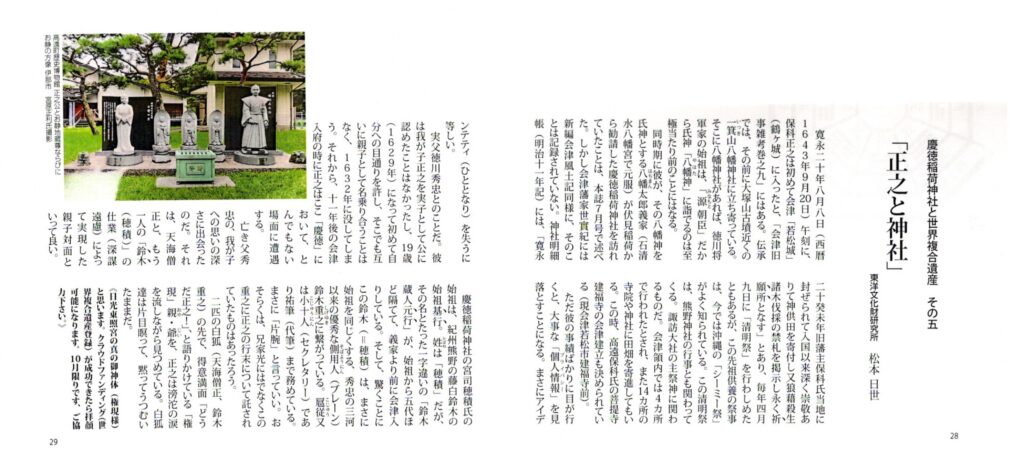Justice and Shrines

Keitoku Inari Shrine and World Heritage Site 5
According to “Aizu Kuji Miscellany, Volume 9,” Hoshina Masayuki entered Aizu-Wakamatsu Castle (Tsuruga Castle) for the first time at noon on August 8, 20th year of the Kanei Era (September 20, 1643). According to legend, he stopped by Ikkiyama Hachiman Shrine near the Otsukayama Tomb before that. If there was a Hachiman Shrine there, it would be perfectly natural for him to visit the clan deity “Hachiman-no-kami” since the founder of the Tokugawa Shogunate was “Minamoto no Ason.”
As mentioned in the July issue of this magazine, around the same time, he visited Keitoku Inari Shrine, which was enshrined by Hachiman Taro Yoshiie (who had his coming-of-age ceremony at Iwashimizu Hachiman-gu Shrine), whose clan deity was Hachiman-no-kami, from Fushimi Inari. However, there is no record of this in the Aizu Clan Family Sejiki, as well as in the Shinpen Aizu Fudoki. The Shrine Details Book (written in the 11th year of the Meiji Era) states that “In the 20th year of the Kan’ei Era, the former feudal lord Hoshina was granted this land, and since his arrival he has deeply revered the area, donated sacred land, and posted a sign prohibiting the cutting down of trees and other violent acts. He has long prayed and made the area a place of prayer.” It also states that he had the “Seimei Festival” held every year on April 9th, and this ancestral memorial service is now better known as the “Shimi Festival” in Okinawa. This Seimei Festival is also related to the Kumano Shrine events. It is related to the main deity of Suwa Taisha. It is said to have been held in four places within the Aizu domain, and he also donated fields to one temple and shrine. At this time, it was also decided to build Kenpukuji Temple, Takato Hoshina’s family temple, in Aizu (now in front of Kenpukuji Temple in Aizuwakamatsu City).
However, if we focus only on his achievements, we will overlook important “personal information.” It is tantamount to losing his identity.
His real father was Tokugawa Hidetada. He never publicly acknowledged his son Masayuki as his real son, and he only allowed Masayuki to meet him when he was 19 years old (1629), and even then they never identified each other as father and son, and he died in 1632. Then, eleven years later, when Masayuki entered Aizu, he encountered an incredible scene here at Keitoku.
He discovered the depth of his late father Hidetada’s affections for his son. It was a meeting between father and son that was made possible by the work (far-sightedness) of Tenkai Sosho and another “Suzuki (Hozumi)”.
The ancestor of the Hozumi clan, the chief priest of Keitoku Inari Shrine, was Motoyuki, the ancestor of the Fujishiro Suzuki clan of Kumano, Kishu. His surname was “Hozumi”, but Suzuki Kurodo Motoyuki, whose name was only one character different from his ancestor’s, entered Aizu before Yoshiie, about five generations after his ancestor. And surprisingly, this Suzuki (=Hozumi) is connected to Suzuki Shigeyuki, Hidetada’s excellent chamberlain (brain) since Mikawa, who shares the same ancestor. His attendant (koju) is a secretary and even serves as a ghostwriter. He can truly be called a “right-hand man.” It is likely that Masayuki’s future was entrusted to Shigeyuki, not his brother Iemitsu.
Two white foxes (Tenkai Sojo and Suzuki Shigeyuki) stand in front of them, and proudly ask, “How is it, Masayuki?” Masayuki looks at them with tears streaming down his face. The white foxes close one eye and look down in silence.
